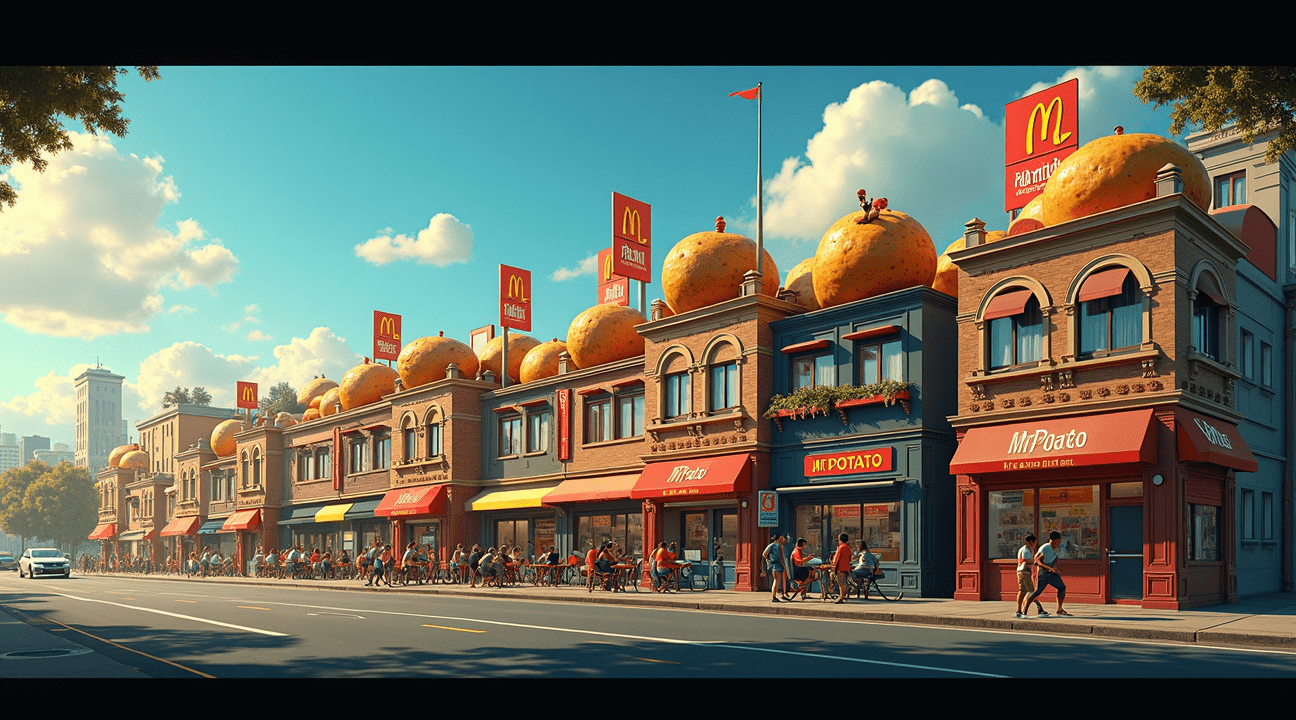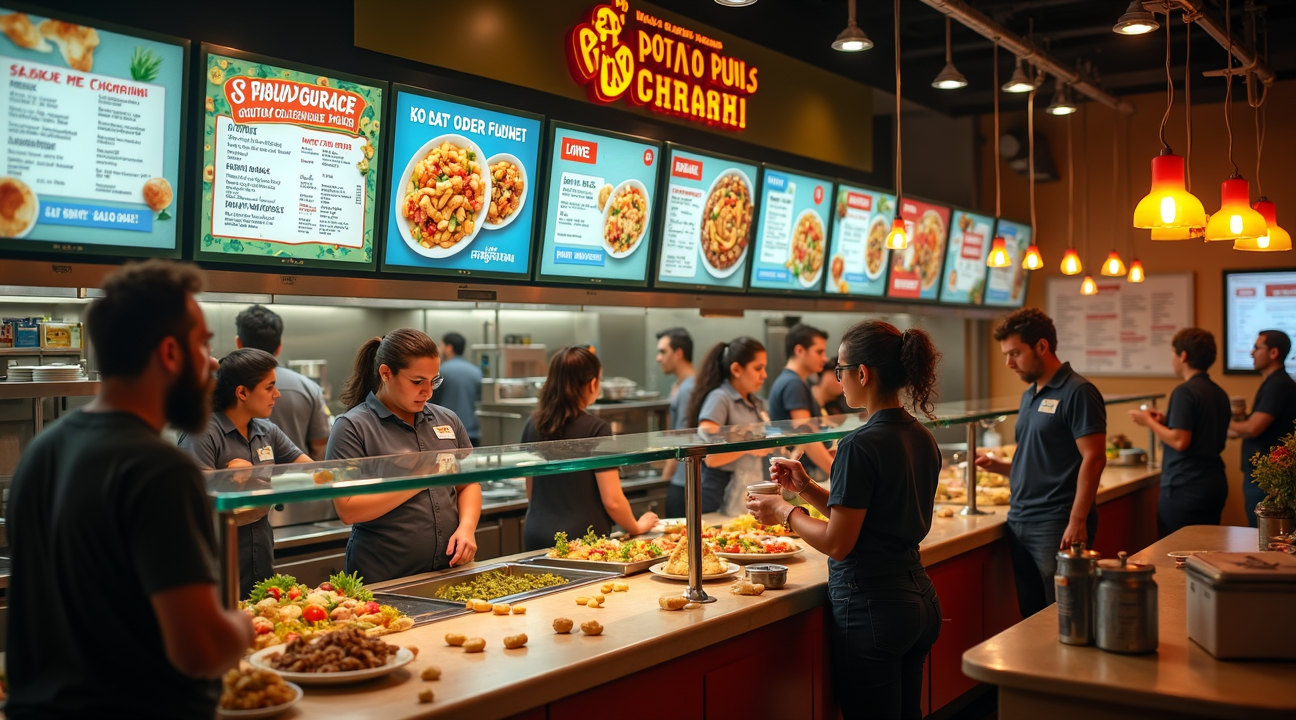Mr Potato’s story stands as one of the most spectacular restaurant failures in recent Australian dining history.
The potato-focused chain collapsed entirely in 2025 after just seven years of operation, despite an initially promising expansion across 13 franchise locations. Founded by former Miss Universe contestant Jess Davis and ex-basketball player Tyson Hoffman, the business faced insurmountable obstacles due to fundamental flaws in its operating model. Franchisee bankruptcies, tax-related forced liquidation, and total disappearance from the market marked the brand’s shocking downfall.
Key Takeaways
- Rapid expansion without sustainable profitability – Mr Potato grew quickly to 13 locations, but most franchisees failed to generate enough income to address basic costs. By the end, 69% of stores had shut down.
- Catastrophic financial impact on franchisees – Many franchisees suffered personal financial ruin, including selling homes, declaring bankruptcy, and losing retirement savings. Operational inefficiencies stemming from an overly complex customizable menu also led to excessive food waste.
- Complete corporate collapse and accountability vacuum – Due to unpaid taxes amounting to $151,000, the company was forced into liquidation. Meanwhile, the founders disappeared from public view, took down the website, and left franchisees unsupported and without pathways for recovery.
- Flawed positioning strategy – Although marketed as a healthy alternative to fast food, the high cost of fresh ingredients conflicted with consumers’ expectations. Additionally, the highly customizable menu caused longer wait times than typical fast food patrons were willing to accept.
- Inadequate franchise support system – Without well-developed training programs, standardized processes, or ongoing operational support, franchisees struggled to manage the business’s complexities largely on their own.
Rapid Collapse Leaves Franchisees Bankrupt and Founders in Hiding
The Mr Potato saga took a devastating turn by July 2025 when the management company faced forced liquidation. The Australian Taxation Office initiated court action over an unpaid tax debt of $151,000, delivering the final blow to an already crumbling operation. This legal intervention exposed the company’s dire financial position and inability to meet even basic tax obligations.
Franchisee Financial Devastation
The human cost of Mr Potato’s failure became starkly apparent as franchisee numbers plummeted from 13 stores to just 4. Store owners discovered that profitability remained elusive across the network, with many struggling to generate sufficient revenue to cover operational costs. Several franchisees faced catastrophic personal consequences:
- Multiple store owners were forced to sell their family homes to cover mounting debts
- Several franchisees filed for personal bankruptcy after exhausting their savings
- Legal disputes emerged between franchisees and the franchisor over unfulfilled support promises
- Some franchisees reported losing their entire retirement funds invested in the venture
The rapid deterioration accelerated in early 2025 when the last two Queensland locations permanently closed their doors in February. These closures left local customers without service and employees without jobs, while franchisees absorbed the final financial losses from lease obligations and equipment costs.
Even the original Adelaide store, which had served as the flagship location and proof of concept for the franchise model, couldn’t survive the systemic problems plaguing the brand. Its closure marked a symbolic end to the Mr Potato experiment and eliminated any remaining credibility the brand might have retained.
By mid-2025, the Mr Potato website disappeared from the internet entirely, removing the last vestige of the company’s digital presence. This online erasure effectively confirmed what industry observers had suspected for months – that Mr Potato had ceased operating as a viable fast food chain. The website’s removal also eliminated crucial information that franchisees and creditors needed to pursue outstanding claims, adding another layer of complexity to an already messy dissolution.
The complete collapse left a trail of financial destruction that extended far beyond the corporate structure. Individual franchisees who had invested their life savings found themselves with worthless agreements and no recourse for recovery, while the founders seemingly vanished from public view, avoiding responsibility for the widespread damage caused by their failed venture.

From Miss Universe to Basketball Courts: The Celebrity Founders Behind the Potato Empire
Mr Potato’s origin story reads like an unlikely partnership between two distinctly different worlds. Jess Davis, a former Miss Universe entrant, joined forces with Tyson Hoffman, a former Adelaide 36ers basketballer who also competed as Tyson Finau, to create what would become Adelaide’s most talked-about fast-food concept in 2018.
The Unlikely Partnership That Started It All
Davis brought her understanding of nutrition and wellness from her pageant background, while Hoffman contributed his athletic perspective on performance-focused eating. Together, they identified a significant gap in the fast-food market for genuinely nutritious options that didn’t sacrifice speed or taste. Their shared vision centered around the humble potato, transforming it from a mere side dish into the star of an entirely new dining experience.
The duo’s complementary skill sets proved instrumental in developing their business model. Davis’s media experience and public speaking abilities paired perfectly with Hoffman’s understanding of team dynamics and competitive drive. This combination allowed them to approach the fast-food industry from a fresh angle, one that prioritized health without compromising the convenience that modern consumers demand.
Building the Brand Through Community Connection
Mr Potato’s founders understood that success in the competitive fast-food landscape required more than just a good product. They needed to build genuine connections with their target audience. Their strategy involved positioning the brand as a solution for health-conscious individuals who refused to settle for typical fast-food options that often left them feeling sluggish or unsatisfied.
The business concept focused on potato-based dishes that could deliver both nutritional value and satisfying flavors. Davis and Hoffman recognized that potatoes, when prepared correctly, offered an excellent foundation for balanced meals rich in complex carbohydrates, fiber, and essential nutrients. Their menu development process emphasized fresh ingredients and cooking methods that preserved the potato’s natural benefits while creating exciting flavor profiles.
Their most ambitious marketing initiative launched in March 2025 with a comprehensive national food truck tour scheduled to run through September. This six-month journey across Australia represents more than just a promotional campaign; it’s designed to support local communities while simultaneously building brand recognition on a national scale. The tour allows the founders to:
- Interact directly with potential customers
- Gather feedback about their offerings
- Demonstrate their commitment to community engagement
This grassroots approach reflects the founders’ belief that authentic brand building requires genuine human connections. Rather than relying solely on digital marketing or traditional advertising, they chose to invest in face-to-face interactions that allow customers to experience the brand’s values firsthand. The food truck tour also provides valuable market research opportunities, helping them understand regional preferences and adapt their offerings accordingly.
Davis’s pageant background proves particularly valuable during these community interactions, as she understands how to connect with diverse audiences and communicate the brand’s message effectively. Meanwhile, Hoffman’s sports background resonates with health-conscious consumers who appreciate his authentic perspective on nutrition and performance.
The founders’ celebrity status, while modest, provides Mr Potato with natural marketing advantages that many startup restaurants lack. Davis’s Miss Universe experience gives the brand instant credibility in discussions about health and wellness, while Hoffman’s professional basketball career adds legitimacy to claims about performance nutrition. However, they’ve been careful to ensure their celebrity backgrounds enhance rather than overshadow the quality of their food and service.
Their strategic timing proved excellent, launching just as Australian consumers began demanding more transparency and nutritional value from their dining options. The founders positioned Mr Potato perfectly to capture this growing market segment by offering the convenience people expect from fast food while delivering the nutritional benefits they increasingly prioritize.
The national tour represents a significant investment in building lasting relationships with customers across Australia. By bringing their concept directly to communities throughout the country, Davis and Hoffman demonstrate their commitment to understanding local tastes and preferences while building the foundation for potential future expansion into those markets.
The Customizable Potato Revolution That Never Took Off
Mr. Potato built its entire concept around the humble baked potato, transforming it into a customizable fast-casual dining experience. I found their approach refreshing compared to traditional burger-and-fries establishments, offering customers the ability to create personalized meals centered on this versatile vegetable.
Menu Innovation and Pricing Strategy
The restaurant offered 13 different types of stuffed baked potatoes, creating a pricing structure that ranged from $4.98 for a classic baked potato to $11.98 for premium options. Their menu featured creative combinations like chicken with broccoli, bacon, and ranch dressing, allowing customers to adjust toppings based on personal taste preferences and calorie goals. This flexibility appealed to health-conscious diners who wanted control over their meal’s nutritional content.
Beyond potatoes, Mr. Potato expanded their offerings to include:
- Soups
- Bread bowls
- Slushies
- Soft drinks
The bread bowls complemented their soup selection perfectly, while the beverage options catered to both adults and children. This diversified menu helped position them as more than just a potato-focused restaurant, though the spud remained their signature item.
Operational Framework and Market Position
Mr. Potato maintained standard fast-food operating hours, serving customers Monday through Saturday from 10 a.m. to 8 p.m., with reduced Sunday hours of 11 a.m. to 6 p.m. These hours positioned them strategically for lunch and dinner crowds, though they missed the breakfast market entirely.
The restaurant’s concept represented an ambitious attempt to carve out a unique niche in the competitive fast-food landscape. Their focus on customization preceded many current industry trends, anticipating consumer demand for personalized dining experiences. However, the potato-centric menu may have limited their appeal to broader audiences accustomed to more traditional fast-food offerings.
The pricing strategy reflected their positioning as a premium fast-casual option rather than a budget-friendly quick-service restaurant. At $11.98 for top-tier options, their prices competed directly with established chains offering more familiar fare. This pricing structure required customers to view baked potatoes as worthy alternatives to burgers, chicken, or pizza — a significant shift in consumer perception that proved challenging to achieve in practice.
Explosive Growth to Spectacular Failure in Just Seven Years
Mr Potato’s journey from startup to shutdown reads like a cautionary tale that fast food entrepreneurs study today. I watched this Australian chain experience one of the most dramatic rises and falls in recent restaurant history, compressing what typically takes decades into just seven turbulent years.
The brand launched in 2018 with ambitious plans to revolutionize the potato-based fast food segment. Franchisees flocked to the concept, attracted by the novelty factor and promising early performance metrics. Within just a few years, Mr Potato had secured 13 franchise locations scattered across Australia, creating what appeared to be a successful regional chain.
However, the rapid expansion that initially seemed like Mr Potato’s greatest strength ultimately became its downfall. By 2024, cracks in the business model had become impossible to ignore. Financial pressures mounted as franchisees struggled with inconsistent foot traffic and rising operational costs.
The Dramatic Collapse
The chain’s decline accelerated with shocking speed during its final year of operation. Franchise numbers plummeted from 13 locations to just 4 stores within twelve months, representing a staggering 69% reduction in the network. This massive contraction signaled deep-rooted problems that went far beyond typical market fluctuations.
Several factors contributed to this spectacular failure:
- Oversaturation of the market without adequate demand analysis
- Inconsistent quality control across franchise locations
- Rising food costs that squeezed already thin profit margins
- Competition from established players who adapted their menus to include premium potato offerings
- Insufficient working capital reserves to weather economic downturns
Franchisees found themselves caught in an impossible situation. Many had invested significant capital into their locations, only to discover that the business model couldn’t sustain profitability at scale. The brand’s management struggled to provide adequate support as their own resources became stretched thin across the shrinking network.
By 2025, Mr Potato officially ceased operations, leaving behind a trail of closed storefronts and disappointed investors. The remaining four locations couldn’t generate enough revenue to keep the corporate structure viable, forcing the inevitable shutdown decision.
Industry analysts point to Mr Potato’s story as a perfect example of how rapid franchise expansion without proper infrastructure can destroy even promising concepts. The company prioritized growth over sustainability, creating a house of cards that collapsed when market conditions shifted. Franchisees who survived the longest reported that corporate support had become virtually non-existent during the final months, leaving them to fend for themselves in an increasingly competitive marketplace.
The Mr Potato experience demonstrates that success in the fast food industry requires more than just an appealing concept. Strong operational systems, adequate capitalization, and realistic growth projections form the foundation that separates sustainable businesses from spectacular failures.

How Mr Potato Failed Where Potato Corner Succeeded Globally
I observed a stark contrast between Mr Potato’s limited impact and the remarkable success of established potato-centric brands like Potato Corner, which expanded to over 1,100 stores worldwide. This comparison reveals critical gaps in Mr Potato’s execution that ultimately led to its struggle for sustainable growth.
Franchise Model Struggles
Mr Potato faced significant challenges with its franchise system that prevented the kind of explosive growth seen by competitors. The company couldn’t establish the franchise profitability metrics that successful chains require for rapid expansion. Franchisees frequently encountered financial difficulties, with many reporting insufficient support systems and unclear profit pathways.
The brand’s franchise model lacked the proven operational frameworks that make chains like Potato Corner attractive to potential investors. I noticed that successful potato-focused restaurants typically provide:
- Comprehensive training programs
- Standardized operating procedures
- Ongoing marketing support
These elements appeared inadequate in Mr Potato’s approach, making it less appealing to new investors and weakening brand cohesion across franchise locations.
Market Positioning Challenges
While Mr Potato positioned itself as a modern, health-oriented alternative in the fast food space, this strategy created its own set of problems. The brand emphasized quick service and customizable meals designed for health and diet preferences, but this positioning proved difficult to communicate effectively to consumers.
Several factors contributed to Mr Potato’s inability to achieve sustained national brand recognition:
- Complex menu options that confused rather than attracted customers
- Higher price points that deterred budget-conscious fast food consumers
- Marketing messages that failed to resonate with target demographics
- Inconsistent brand experience across locations due to poor franchisee training
The company couldn’t overcome market headwinds that established competitors had already navigated successfully. Potato Corner’s simpler concept—focusing primarily on flavored fries with consistent quality—proved more scalable than Mr Potato’s broader health-focused approach.
I found that Mr Potato’s emphasis on customization, while appealing in theory, created operational complexity that many franchisees couldn’t manage effectively. This led to inconsistent customer experiences and damaged the brand’s reputation in key markets. The company’s inability to provide adequate franchisee support meant that individual locations often struggled with inventory management, staff training, and maintaining food quality standards that the health-focused positioning demanded.

The Harsh Reality Behind the Healthy Fast Food Dream
Mr. Potato Head’s Restaurant positioned itself as a revolutionary health-conscious alternative in the fast food industry, promising customers the ability to customize meals according to their specific dietary needs and health preferences. The concept seemed perfect for a market increasingly focused on wellness and nutrition, offering quick service without compromising on healthy ingredients.
The restaurant chain marketed itself aggressively as the solution to America’s fast food dilemma. Customers could build their own potato-based meals, choosing from an array of fresh toppings, lean proteins, and nutritious sauces. I observed how the brand emphasized speed and customization, creating an appealing proposition for health-conscious consumers who didn’t want to sacrifice convenience for nutrition.
When Good Intentions Meet Business Realities
Despite the promising concept, the business model contained fundamental flaws that became apparent as operations scaled. The customizable approach, while appealing to customers, created significant operational challenges that franchise owners struggled to manage effectively. Kitchen workflows became complicated, order times increased, and food costs spiraled beyond projections.
Franchise support proved inadequate as the company expanded rapidly. Many franchise owners reported receiving insufficient training on the complex operational systems required to manage the customizable menu efficiently. The corporate team failed to provide the level of ongoing support necessary for such an intricate business model to succeed at scale.
Profitability issues emerged almost immediately across multiple locations. The fresh ingredients required for the health-focused menu commanded premium prices, yet the fast food market demanded competitive pricing. This created an unsustainable cost structure that squeezed profit margins to dangerous levels. Franchise owners found themselves caught between maintaining quality standards and achieving financial viability.
Food waste became another critical issue as the emphasis on fresh ingredients meant shorter shelf lives and more frequent spoilage. The customizable nature of orders made it difficult to predict inventory needs accurately, leading to either:
- Stockouts that disappointed customers
- Excess inventory that had to be discarded
Labor costs also exceeded expectations as the complex preparation requirements demanded more skilled kitchen staff and longer training periods. The promise of quick service became increasingly difficult to deliver as order complexity grew, leading to customer dissatisfaction and reduced repeat business.
Store closures began within the first two years of operation, with franchise owners citing inadequate corporate support and unsustainable operating costs. Many reported that the initial financial projections provided during the franchise sales process bore little resemblance to actual operational realities. The gap between marketing promises and business performance created significant financial hardship for investors who had committed substantial capital to the concept.
The company’s failure to adapt the business model based on early operational feedback compounded these problems. While franchise owners reported consistent issues with profitability and operational complexity, corporate leadership continued pursuing aggressive expansion rather than addressing fundamental business model flaws.
Market research revealed that while customers appreciated the healthy options, many weren’t willing to pay the premium prices necessary to make the concept profitable. The target demographic proved smaller than anticipated, limiting revenue potential across locations. Additionally, preparation times for customized orders often exceeded customer expectations for fast food service, creating a disconnect between brand positioning and actual experience.
The widespread closures that followed represented more than just business failures; they devastated the financial lives of franchise owners who had invested their savings and taken on significant debt to participate in what appeared to be an innovative concept.
Many reported:
- Losing their entire investment
- Facing ongoing liability for lease obligations
- Dealing with equipment financing debt
The Mr. Potato Head’s Restaurant experience serves as a cautionary tale about the challenges of implementing complex operational models in the fast food industry. While the health-conscious positioning resonated with market trends, the execution required operational excellence that the company couldn’t deliver at scale. The disconnect between marketing promises and business realities ultimately proved fatal to both the brand and the financial wellbeing of its franchise partners.

Sources:
7News Australia – “Mr Potato management goes into liquidation after court action over tax debts”
WJON – “Mr Potato joins St. Cloud’s Crossroads Center food court”
Sydney Times – “Founders of Mr Potato Jess Davis and Tyson Hoffman announce inaugural national food truck tour”
Wikipedia – “Potato Corner”


